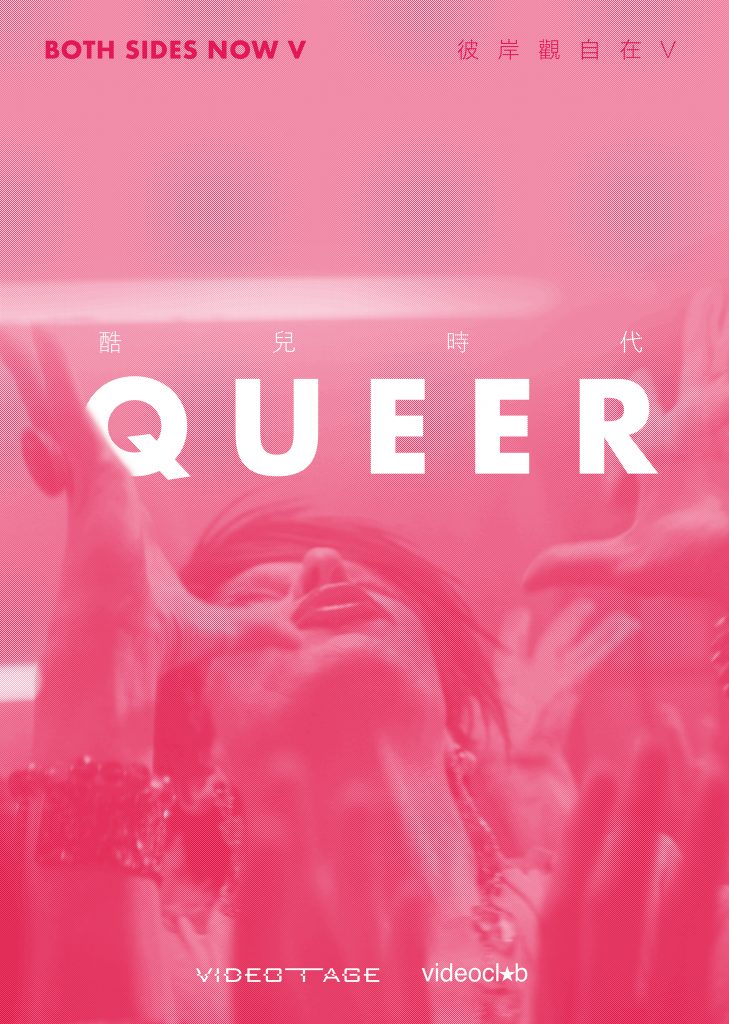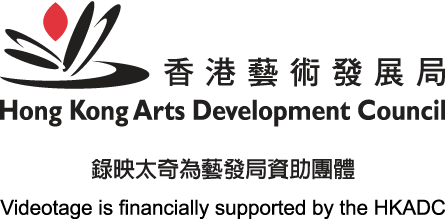(For English, Please Scroll Down)
2019 錄像廳 – 《彼岸觀自在V》放映
時間:2019.05.04-12 1-7pm
地點:台北當代藝術中心(台北市大同區保安街49巷11號,近捷運大橋頭站)
由香港錄映太奇(Videotage)與英國 videoclub 共同策劃,《彼岸觀自在V》將以酷兒時代(Queer)為題,在英國、香港、台灣、西班牙及法國呈獻一連串活動,展示英國、香港和中國當代和歷史錄像及媒體作品。台北當代藝術中心作為串連機構之一,將於錄像廳空間在5月4日至12日呈現錄像作品放映。
酷兒運動經過多年的發展,今日已開拓出寬闊的光譜,酷兒社群比以往更壯大。但隨著後殖民主義與右翼思想在近年社會大行其道,酷兒須面對更大的挑戰。為了回應這個時代, 錄映太奇的梁學彬及 videoclub 的 Jamie Wyld,精選一系列來自英國、香港和中國的錄像,作為《彼岸觀自在V》的主題節目,其中包括來自香港錄像藝術先鋒麥海珊、新加坡著名錄像藝術家黃漢明、去年英國泰特美術館透納獎得主Charlotte Prodger的作品等等,探討LGBTQI+生活和性別議題,反思酷兒與當今社會的權力關係。
策展論述
《彼岸觀自在V》旨在探討一眾藝術家與影人如何探究酷兒文化,以及他們如何以用各種影像手法,探索英國與香港的酷兒生活百態。
LGBT群體在法律上備受歧視,而男同性戀所受的歧視尤其嚴重,此現象背後,有深遠的英國殖民主義影響(女同性戀無論在英國或殖民地,皆未受到重視)。香港與其他殖民地一樣,要改變視同性戀為罪行的法律,需時十分漫長。英國早在1967年合法化同性戀,香港卻要到1991年才合法化同性戀。到2019年,英國和香港就LGBTQ+平權的立法已大致相等,儘管不同地區、世代、群體的人,對酷兒的接受程度皆不盡相同。而右派情緒於全球崛起後,酷兒群體得到的接納似乎越來越少。
為了回應後殖民主義與右翼思想的崛起,我們特別策展是次節目,展出一系列探索酷兒身份與文化的藝術作品。來自英國和香港的影人,將藉流動影像展示LGBTQI+的生活;兩地的藝術家則會以作品反思酷兒的身份、生活與創作。
自從錄像藝術出現,藝術家就憑手提錄影機,開拓一股顛覆傳統的力量,挑戰主流對身份的敘述。1980年代晚期至1990年代,香港前衛藝術家對流動影像的興趣越來越濃厚,用它在世俗社會規範外開拓出一片酷兒天地。在主流電影敘述中,中心地位往往由男性主人翁佔據,這些藝術家卻將這慣例打破。在同性戀等種種酷兒身份仍被視作禁忌的時代裡,他們講述無人知曉的故事,為小眾發聲。這些藝術家努力為理所當然的常態作更深層次的反思,將身體、社會及文化重新構想成流動的整體,令打破常規變得可能,為社會變革打開了大門。女性主義興起、LGBT權益日益得到關注,都與前衛藝術和錄像藝術息息相關。
在過去的數十年,各地社會見證著性╱別打破尋常界限,發展出寬闊的光譜。酷兒社群生活上時刻面對疏離與排斥,但他們已進化成一個相對上較開放的羣體。一方面,很多地方正逐步制定更自由的法律,例如合法化同性婚姻;同志酒吧遍地開花,彩虹產業蓬勃發展,以LGBT為主題的電影越來越受歡迎,使這個社羣更強大,能容納更多不同的性傾向及性別。另一方面,新自由主義敘述塑造了更多元的社會,裡面每個人都享有更大自由。過往的種種跨界行為、流動身份、奇異構想,今日已得到商業世界和市場接受,漸成「正常」:幾乎所有金融企業都有份贊助同志遊行;中國的LGBT市場,估計價值約3000億元。同性戀者的生活漸受新文化經濟秩序影響,新自由主義世界重新定義了酷兒,又否定了酷兒。而在這些轉變以外,世上無數地方仍有極端右翼主義者煽動恐同,LGBT面對的迫害無日無之。我們這個時代的酷兒,揭示權力結構正不斷變化,當中的關係複雜而又矛盾。酷兒概念曾被視作小眾、危險,在急速轉變的環球政治中,它的角色為何?
《彼岸觀自在V》嘗試重探歷史,觀照當下,重新審視酷兒的概念。我們希望藉這一系列流動影像,深入探討個人經歷,從本地及全球角度,對形形色色的「酷兒」概念提出疑問。
《彼岸觀自在》是策略性項目,旨在從動態影像作品,探討中國、香港和英國等各國文化及社會。
-梁學彬(錄映太奇)& Jamie Wyld (videoclub)
放映作品:
Differences Do Matter 《大不同》 Anson Mak 麥海珊, 1998, 3’00”
《大不同》從聲音與影像、性身份、大眾傳媒的呈現以及街頭運動,探究「不同」此概念。作者從自身出發,由一開始發聲自述個人聲音就存在著變化與不同,延伸至成長居住環境、不是「同志」身份(作者是雙性戀),後至社會政治,嘗試呈現「我」與他者之間因為不同而形成身份與思想表達上的分別和可能性。最後,作品反思影像及其採用的字幕如何影響語議解讀,作為 文化和政治翻譯的困難。當《大不同》就「不同」述說個人故事與觀點時,同時象徵「我」與時代環境的關係。
A Glass of Water《本是一清水》 Siu-man Wu 胡兆雯, 2019, 4’30”
作品透過不同物質(人與物)的互動,探討「人」與「人」、「人」與「物」,及「物」與「物」之間的關係。以〈倚傍〉(中)作出發點,縱然杯處於不穩定的傾斜狀態,其中的水卻平靜而穩定。如何在充滿不確定因素的環境之中保持關係的平衡成為作品的重點。〈對話〉(右)表現了物質之間的互動,其中包括了人與人的對話及人與物的角力。人的肢體、杯的狀態,或是水的波動均為物質互動所產生的現象,而此現象亦體現了關係的狀態。在〈佚失〉(左)中,以手作容器,將水一分為二。然而,水卻在過程中有所佚失,使之不能再合二為一。而水的質量亦被手上的灰塵或是皮膚上的表層組織污染而變得渾濁。
Teach German with Petra Von Kant 《跟柏蒂娜學德語》 Ming Wong 黃漢明, 2017, 8’00”
《柏蒂娜的苦淚》為已故德國導演寧那‧華納‧法斯賓達中的作品,講述一位事業有成的時裝設計師和女同性戀者——柏蒂娜,瘋狂地愛上了一個美麗的年輕女子,並試圖通過將對方打造成時裝模特,把她牢牢拴在自己身邊。
黃漢明於2007年準備動身定居柏林前夕,「重拍」了《柏蒂娜的苦淚》,取名為《跟柏蒂娜學德語》。黃漢明移居柏林之時沒有參加語言課程,卻設計了一套「語言與文化融匯項目」,將電影的高潮部分作為他聯結二者的紐帶。
作品中,他扮演成柏蒂娜,表演她情緒崩壞的一場戲,藉此預演「自己作為一個超過35歲的單身、同性戀、少數族裔、處於職業生涯中期的藝術家,在搬到柏林以後所可能遇到的情況中,會經歷的動作、情感以及要表達的言辭——例如感到痛苦、絕望,或者潰不成軍。」
The Drum Tower《鼓樓西》 Fan Po Po 范坡坡, 2018, 17’52”
北京鼓樓矗立在這座帝都的中心,默默注視著城市正遭遇的激烈變革:“拆牆打洞”的整治運動之下,無數原本充滿活力的小商店和酒吧咖啡館被封牆關停。高中男生卡醬成日逃學在胡同里閒逛。一次廁所裡的偶然相遇,他對古著店的老闆米姐產生極大興趣。米姐的跨性別身份讓她遭遇生活中諸多的不方便,如今她的店面也面臨著關門的命運。卡醬默默凝視著她的生活卻愛莫能助,直到有天這一切真的被摧毀…
本片藝術化的融合了性別麻煩與城市變遷的雙重議題,也是中國第一部全部由跨性別演員主演的影片。
Handclap/Punchhole, Charlotte Prodger , 2011, 9’46”
拍板(Handclap)/ 穿孔(Punchhole),意指電影製作裡用菲林拍攝時兩種使錄製聲音與畫面同步的技術。Prodger在作品裡卻故意令聲畫不同步,甚至使他們以完全相反的方式出現,即影像僅在聲音不存在時出現,反之亦然。裝置方法是用一部Sharp GF 767 Boombox揚聲器來播放預先錄製的錄音帶。被視為Boombox中的極品,Sharp GF 767於1982年甫面世便在街頭巷尾掀起風潮。在Prodger作品中,Boombox播放的聲音與放映機播放默片菲林的機器聲並置、較勁。電影紀錄了歷史洪流中一段小插曲——一個被重新定位為主流旅遊景點的在歷史環境裡,一個反傳統文化的酷兒身體,與此同時,Boombox中的錄音帶卻講述著一段段在群眾間口耳相傳的口述歷史,細訴菲林電影消亡與同志尋歡空間消失的故事。透過酷兒的主觀視角,觸碰媒體複製技術的限制。
Something Said, Jay Bernard, 2017, 7’33”
1981年,英國倫敦新十字區一個派對發生大火,造成13名年輕黑人死亡。然而,當時政府、傳媒和警察均卻對慘劇投以冷漠態度 。儘管當年極右在區內活躍,派對當晚又引起鄰居糾紛⋯⋯疑點重重但結果無人需承擔責任,引發後來20,000人上街抗議。多年後歷史陰霾未散,保守右翼勢力竟又再崛起,藝術家決意在Something Said重現Yvonne Ruddock的精神:當晚大火前,Yvonne Ruddock正在慶祝其16歲生辰,卻不幸在火災中逝世。
God is Watching, Matt Lambert, 2017, 3’24”
在這件作品裡,英國前衛行為藝術家David Hoyle(他的其他身份包括:「反.變裝皇后」[anti-drag queen]、前衛歌舞表演者、歌手、導演等)回憶他第一次到同志夜店的經歷,同時暢談對同志來說安全的空間存在之重要性。God is Watching為藝術家Matt Lambert受英國泰特美術館及Random Acts委託而創作之作品。
Where We Are Now, Lucie Rachel, 2016, 9’29”
Where We Are Now以個人的角度出發,展現一個年輕女子和其跨性別父/母親,以及兩人之間一直在變化的關係。他們一方面以一種新的開放態度反思兩人關係,另一方面互相分享他們出櫃的感受,這家人想知道,既然已決定接受種種改變,他們的未來會是甚麼樣子。
Dear Samuel, Rob Crosse, 2019, 9’30”
Dear Samuel是一個關於跨代慾望的故事,從偏愛老年男人的年輕男子角度出發,探討老年/年輕關係中的責任和關懷的理念。藝術家在香港駐留時,受到自身經歷及與年長同志團體「晚同牽」相處所啟發而創下此作。作品透過同時使用獨白和歌唱兩種手法,檢視對不平等權力關係的認知、觀念——無論是個人或政治上,以及在脆弱無助之時尋求的互助支持。
本活動由 ![]() 與
與 ![]() 共同策劃。
共同策劃。
2019 Video Lounge – Both Sides Now V
Time:2019.05.04-12 1-7pm
Venue:Taipei Contemporary Art Center(No.11, Lane 49, Baoan Street, Datong District,Taipei)
Both Sides Now V, the fifth edition of a long term project partnered between Videotage (HK) and videoclub (UK) presenting contemporary and historical films and video works from the UK, Hong Kong, and China. The 2019 edition is programmed under the theme “Queer” with a series of screenings and thematic events in the UK, Hong Kong, Taiwan, Spain and France. Taipei Contemporary Art Center (TCAC) is going to present the screening in Video Lounge from May 4 to 12.
Over the years, LGBTQ people have formed a huge and vibrant community that includes spectrums of sexual practices and gender. Yet, with the rise of right-wing sentiments globally, the acceptance Queer people have enjoyed feels like it is in descent. In response to this, Isaac Leung from Videotage and Jamie Wyld from videoclub have selected a series of video artwork from the UK, Hong Kong and China under the theme “Queer”. The line-up includes one of the most important local video artists Anson Mak, internationally acclaimed media artist Ming Wong, the winner of the Turner Prize of Tate Modern in 2018 Charlotte Prodger, and some of the very talented artists from the region and the UK. The screening aims to explore aspects of LGBTQI+ life and reflect upon the power dynamics between queerness and contemporary society.
Curatorial Statement
Both Sides Now V looks at the way in which artist filmmakers are exploring Queer culture, using various film and video techniques, to explore aspects of Queer life in Hong Kong and the UK.
British colonialism widely affected legal discrimination against LGBT people – specifically homosexual men (just as in Britain, female homosexuality was not recognised in colonies). As in many colonies, laws criminalising male homosexuality were slow to change in Hong Kong, with decriminalisation taking until 1991, as opposed to 1967 in the UK. In 2019, laws regarding equality for LGBTQ+ people are almost equal. Though reception to Queer people in the UK and Hong Kong varies widely geographically, generationally and socially. With the rise of right-wing sentiments globally, the acceptance Queer people have enjoyed feels like it is in descent.
In response to post-colonialism and the rise of right-wing opinions, we have curated this programme to show a range of artworks that explore Queer identity and culture. Filmmakers from both sides explore aspects of LGBTQI+ life – with artists from both the UK and Hong Kong making work that reflects upon Queer identity, life and creativity.
Ever since video art first appeared as a medium, artists have been using portable cameras to explore the subversive potential of video and challenge mainstream discourse about identities. In Hong Kong, the late 1980s and 1990s witnessed a growing interest among avant-garde artists, who used video to claim a queer space amongst the mundane social codes. They disrupted the male hero’s central status in mainstream cinema’s narrative. They have also recounted unspoken stories and given voice to the marginalized in a time when homosexuality and many other identities were considered taboo. These artists have sought to complicate the understanding of what it means to be taken-for-granted and have reimagined the body, society and culture as a constant flux, which has the potential to unpack norms and open society to transformation. Avant-garde and video art go hand-in-hand with the emergence of the feminist movement and the growing public visibility of the demand for LGBT rights.
In the last few decades, many societies have witnessed a radical change in promoting a diverse spectrum of non-normative sexual and gender identities. Queer communities, whose lives are organized around constant social alienation and exclusion, have evolved into a relatively more open community. On one hand, many societies are progressively creating more liberal laws, such as legalizing same-sex marriage. The thriving gay bar scene, booming rainbow industry and increasingly popular LGBT-themed movies have built a stronger community and increased inclusivity for spectrums of sexual practices and gender. On the other hand, individual freedom and promises of diversity are increasingly fashioned by neoliberal discourses. The former border-crossing practices, fluid identities and peculiar imaginations are now commercialized, marketized and normalized. Almost every financial corporation has joined hands in sponsoring pride parades. In China, the LGBT market places is valued at approximately $300 billion dollars. The way that gay and lesbian people live is increasingly mediated by the new order of cultural economy. Queerness has been redefined and contradicted by the neoliberal reality. Apart from these changes, in many parts of the world, a parallel rise in violent homophobia has been promoted by right-wing extremists. Anti-LGBT abuse and victimization remains frequent. Queerness in our time has revealed that power dynamics appear to be shifting, complex and yet contradictory. How has queerness, once considered marginal or subversive, played a role in the radically shifting figurations of global politics?
Both Sides Now V attempts to reconsider queerness by looking into historical perspectives and its relevance to the present. Through this collection of films, we aim to investigate personal experiences and problematize the various notions of “queer” from local and global perspectives.
Both Sides Now is a tactical program that uses film and video to explore culture and society between different nations, the UK, China and Hong Kong, and beyond.
– Isaac Leung (Videotage) & Jamie Wyld (videoclub)
About the works:
Differences Do Matter 《大不同》 Anson Mak 麥海珊, 1998, 3’00”
“Differences Do Matter” interpellates the concept of “difference” from sound and image, sexual identity, demonstrations and their representations on mass media. From the beginning of the video, the artist self-narrates the changes of her voice, then further explores the differences in her living environments, not a “tong chi identity (artist is bisexual), and engagements in social politics. The artist attempts to (re)present the differences and possibilities of herself in terms of identity and mode of thought between “I” and others from a self-reflexive exploration. In the end, the work reflects how images and subtitles affect the linguistic interpretation as problematic issue of cultural and political translation. While”Difference Do Matter” narrates personal stories and perspectives about “difference”, it also represents the relationship between “I” and the historical contexts.
A Glass of Water《本是一清水》 Siu-man Wu 胡兆雯, 2019, 4’30”
Lost, But Need Not Be Found (Left)
I divide a glass of water into two. Considering my hand as a discrete object and a container, I transfer the water from a full glass into an empty one until the volume is even. In the splitting process, losses occur; water is dropped on the table and absorbed by my skin. The divided water thus cannot be combined into one again. The quality of the water is changed by my hand as it is mixed with skin cells and dust.
Stand Straight, Oh No (Middle)
A tilting glass of water displays a state of unstable stability. The water inside keeps a horizontal line even when the glass is in an inclined position. Therefore, it does not matter if the glass is stable or not, the water inside remains calm and steady.
Come On, You Know What I mean (Right)
To maintain the balance of this glass of water, the two people use a finger to hold each side of the glass while they are having a dialogue. In the conversation, their emotion changes according to the context and it can be reflected by their body language or their fingers on the glass.
Teach German with Petra Von Kant 《跟柏蒂娜學德語》 Ming Wong 黃漢明, 2017, 8’00”
In 2007 just before moving to Berlin, I made Lerne Deutsch mit Petra von Kant / Learn German with Petra von Kant in which I tried to learn to speak and act like a German by closely emulating the actress Margit Carstensen in the role of fashion designer Petra von Kant, suffering a mid-life-career-crisis in Rainer Werner Fassbinder ́s 1972 film Die bitteren Tränen der Petra von Kant (The Bitter Tears of Petra von Kant).
In the time since I moved to Berlin, Petra von Kant’s expressiveness has given me the words (and attitude!) I needed to overcome similar moments of despair and desperation. From what started as an exercise for a self-designed “integration course” in Germany – who would have guessed? – ten years later I would find myself in the role of a professor at UdK, the University of the Arts in Berlin.
The Drum Tower《鼓樓西》 Fan Po Po 范坡坡, 2018, 17’52”
Drum Tower is located in the downtown of Beijing. It has witnessed the gentrification of this city and the government’s sealing up on small businesses. Kacchan is a senior school student who wanders through hutong every day, escaping from classes. Once by accident, he meets a vintage shop owner in a public toilet and is fascinated by her, Miss Mi. The identity of being a transgender brings some inconvenience to Miss Mi’s life, at the same time her vintage shop is faced with being demolished. Kacchan sees her life in his eyes but can’t do anything to help, until the very day comes…
This film combines the theme of sexuality and urban changes in an artistic way. It is also the first film in China where all the leading performers are transgender.
Handclap/Punchhole, Charlotte Prodger, 2011, 9’46”
Handclap/Punchhole takes its name from two technical actions used in the film industry to synch recorded sound with celluloid. Conversely, Prodger displaces of sound and image here – to the point where they play out in inverse relation to the other: image is only present when sound is not, and vice versa. The installation includes a spoken word audio tape playing on a Sharp GF 767. Considered the holy grail of boomboxes, it was designed in 1982 to drown out all other boomboxes on the street. Here, it is competing with the mechanical clatter of silent images traveling through the film projector. While the film documents a small intervention – a queer countercultural body in an historical environment which has been repositioned into a mainstream tourist attraction – the tape on the boombox plays a collection of cross-pollinating oral histories describing the increasing obsolescence of analogue cinema simultaneously with the obliteration of gay cruising spaces: queer subjectivity brushing up against the limits of reproductive technology.
Something Said, Jay Bernard, 2017, 7’33”
In 1981, the New Cross Fire tragically claimed the lives of 13 young black people and was met with state, media and police indifference. Haunted by that history, and in the context of the recent rise of the far right, Something Said resurrects the spirit of Yvonne Ruddock, whose 16th birthday was being celebrated the night of the fire.
God is Watching, Matt Lambert, 2017, 3’24”
The avant-garde performance artist, David Hoyle remembers his first visit to a gay club, and discusses the importance of safe spaces. Commissioned by Tate and Random Acts.
Where We Are Now, Lucie Rachel, 2016, 9’29”
A personal insight into the changing relationship between a young woman and her transgender parent. Reflecting on their relationship with a newfound openness and sharing experiences of coming out, they wonder what the future looks like now the decision to transition has been made.
Dear Samuel, Rob Crosse, 2019, 9’30”
Dear Samuel is a story about intergenerational desire exploring ideas of care and duty through the perspective of a younger man attracted to older men. Inspired by time spent with a group from Hong Kong called Gay and Grey and from Crosse‘s personal experiences, the work uses both narration and song to examine perceptions of an unequal power balance – be it personal or political – and the search for support during moments of vulnerability. Please feel free to sing along.
The screening is organized by ![]() and
and ![]()



 支持。
支持。